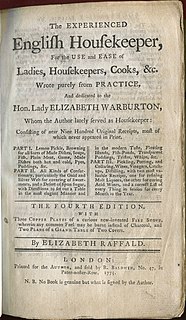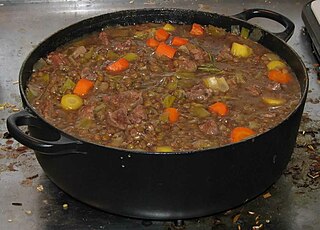Portable soup was a kind of dehydrated food of English origin used in the 18th and 19th centuries. It was a precursor of meat extract and bouillon cubes, and of industrially dehydrated and instant food. It is also known as pocket soup or veal glue. It is essentially a partially dehydrated broth and a solid counterpart of glace de viande in French cuisine. It was long a staple of British seamen, military and explorers, as it would keep for many months or even a year. In this context, it was considered a filling and nutritious dish.

Scotch broth is a filling soup, originating in Scotland. The principal ingredients are usually barley, stewing or braising cuts of lamb, mutton or beef, root vegetables, and dried pulses. Cabbage and leeks are often added shortly before serving to preserve their texture, colour and flavours. The proportions and ingredients vary according to the recipe or availability. Scotch broth has been sold ready-prepared in tins for many years.

Tripe is a type of edible lining from the stomachs of various farm animals. Most tripe is from cattle, pigs and sheep.

Tobias George Smollett was a Scottish poet and author. He was best known for picaresque novels such as The Adventures of Roderick Random (1748), The Adventures of Peregrine Pickle (1751) and The Expedition of Humphry Clinker (1771), which influenced later novelists, including Charles Dickens. His novels were liberally altered by contemporary printers; an authoritative edition of each was edited by Dr O. M. Brack Jr and others.

Goulash is a soup or stew of meat and vegetables seasoned with paprika and other spices. Originating in Hungary, goulash is a common meal predominantly eaten in Central Europe but also in other parts of Europe. It is one of the national dishes of Hungary and a symbol of the country.

Brisket is a cut of meat from the breast or lower chest of beef or veal. The beef brisket is one of the nine beef primal cuts, though the definition of the cut differs internationally. The brisket muscles include the superficial and deep pectorals. As cattle do not have collar bones, these muscles support about 60% of the body weight of standing or moving cattle. This requires a significant amount of connective tissue, so the resulting meat must be cooked correctly to tenderise it.

Sukiyaki is a Japanese dish that is prepared and served in the nabemono style.
An entrée in modern French table service and that of much of the English-speaking world is a dish served before the main course of a meal. Outside North America, it is generally synonymous with the terms hors d'oeuvre, appetizer, or starter. It may be the first dish served, or it may follow a soup or other small dish or dishes. In the United States and parts of Canada, the term entrée refers to the main dish or the only dish of a meal.
A billycan is an Australian term for a lightweight cooking pot in the form of a metal bucket commonly used for boiling water, making tea/coffee or cooking over a campfire or to carry water. These utensils are more commonly known simply as a billy or occasionally as a billy can.

Scouse is a type of stew, typically made from chunks of meat, usually beef or lamb, potatoes and onion. It is particularly associated with the port of Liverpool, which is why the inhabitants of that city are often referred to as "scousers". The word comes from lobscouse, a stew commonly eaten by sailors throughout northern Europe in the past, and surviving in different forms there today.

Cawl is a Welsh dish. In modern Welsh the word is used for any soup or broth; in English it refers to a traditional Welsh soup, usually called cawl Cymreig in Welsh. Historically, ingredients tended to vary, but the most common recipes are with lamb or beef with leeks, potatoes, swedes, carrots and other seasonal vegetables. Cawl is recognised as a national dish of Wales.

Burgoo is a stew, similar to Irish or Mulligan stew, often served with cornbread or corn muffins. It is often prepared communally as a social gathering. It is popular as the basis for civic fund-raisers in the American Midwest and South.

Nikujaga is a Japanese dish of meat, potatoes and onion stewed in sweetened soy sauce and mirin, sometimes with ito konnyaku and vegetables. Nikujaga is an example of yōshoku. Generally, potatoes make up the bulk of the dish, with meat mostly serving as a source of flavor. It is usually boiled until most of the liquid has been reduced. Thinly sliced beef is the most common meat used, although minced or ground beef is also popular. Pork is often used instead of beef in eastern Japan.

Batchoy, less commonly spelled batsoy, is a noodle soup made with pork offal, crushed pork cracklings, chicken stock, beef loin and round noodles. Its origins can be traced to the district of La Paz, Iloilo City in the Philippines, hence it is often referred to as La Paz Batchoy.

Bully beef is a variety of meat made from finely minced corned beef in a small amount of gelatin. The name "bully beef" likely comes from the French bouilli in Napoleonic times, or possibly from the head of a bull depicted on the popular Hereford brand of canned corned beef. The cans have a distinctive oblong shape. Bully beef and hardtack biscuits were the main field rations of the British Army from the Boer War to World War II. It is commonly served sliced in a corned beef sandwich. Potato-based dishes, such as "hash and hotch-potch", in which the potatoes and beef are stewed together, and "corned beef hash", where pre-boiled potatoes and corned beef are mixed with Worcestershire sauce then fried, are also made. Tinned corned beef is also used in France. Some places where British troops had a heavy presence in the 20th century, such as Malta, have adopted bully beef as part of their national cuisine. In February 2009, the British Defence Equipment and Support announced that they would be phasing out bully beef from ration packs as part of the introduction of the new Multi-Climate Ration Packs until this change was reversed due to backlash.
Hodge-podge or hotch potch is a soup or stew, usually based on diced mutton or other meat, with green and root vegetables. It is familiar in different versions in Britain and North America and is particularly associated with Scotland.

Panackelty is a beef or lamb casserole traditional throughout the northeast of England, especially associated with County Durham and in particular Sunderland. It consists of meat, mainly corned beef, and root vegetables, mainly potatoes, onions and carrots, all left to bake throughout the day in an oven pot on low heat, or cooked slowly on a low heat in a pan. Its name derives from the fact that it is cooked in a pan. The dish exists in a number of local variations that differ in name, meat and vegetable content. This dish is also referred to as tatey pot or corned beef and tatey pot.

The Experienced English Housekeeper is a cookery book by the English businesswoman Elizabeth Raffald (1733–1781). It was first published in 1769, and went through 13 authorised editions and at least 23 pirated ones.

A stew is a combination of solid food ingredients that have been cooked in liquid and served in the resultant gravy. A stew needs to have raw ingredients added to the gravy. Ingredients in a stew can include any combination of vegetables and may include meat, especially tougher meats suitable for slow-cooking, such as beef, pork, lamb, poultry, sausages, and seafood. While water can be used as the stew-cooking liquid, stock is also common. A small amount of red wine is sometimes added for flavour. Seasoning and flavourings may also be added. Stews are typically cooked at a relatively low temperature, allowing flavours to mingle.















